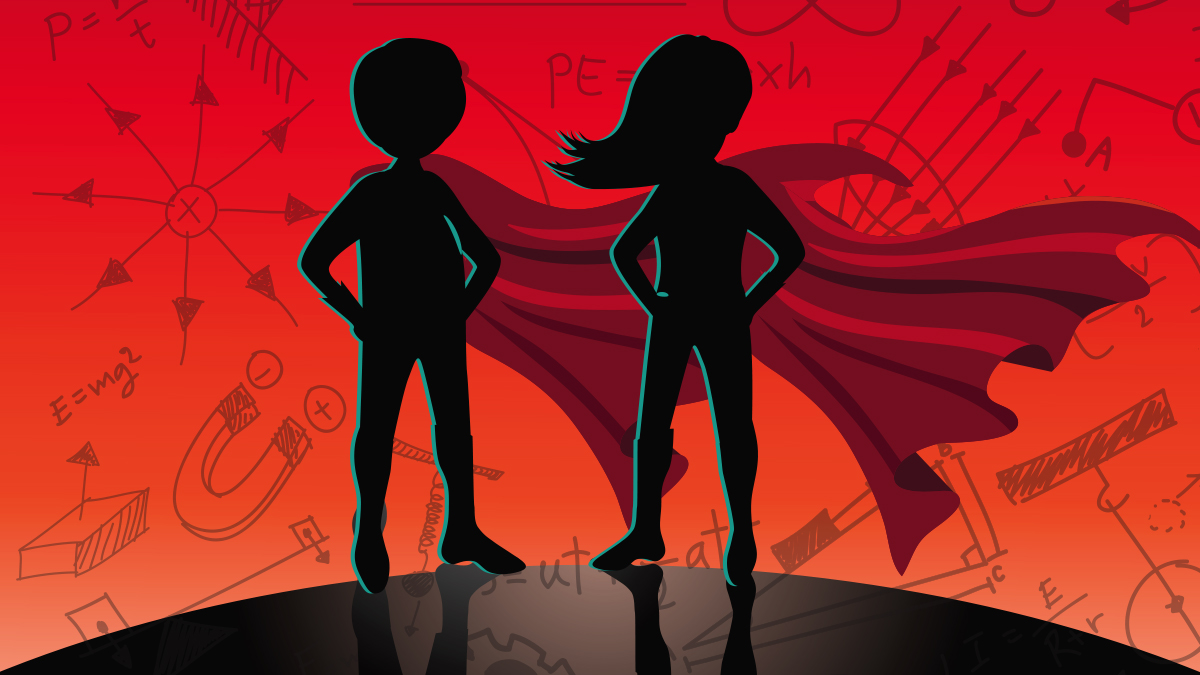Superhero Physics
Eighth Graders Learn Physics Concepts From Superhero-Inspired Lessons
Over the past decade, the proliferation of superhero movies has exploded. Marvel and DC comics have brought a number of heroes to the big screen, including Superman, Batman, and Guardians of the Galaxy. Although the heroes fight crime and uphold the law, few abide by the laws of physics. To tap into students’ interests, students were presented with a challenge: Develop a lesson to teach a physics concept centered on the (accurate or inaccurate) depiction of that concept in a superhero movie. The goal of this project was for students to become “experts” on their selected concepts and then design interactive lessons to teach their classmates about it.
Socratic seminars
To get students to see this connection, we read the article, “The Science of Superheroes” (Weiner 2008) and discussed the article in a “Socratic seminar,” a formal discussion, based on text, in which a leader (at first the teacher, but ultimately students) asks open-ended questions designed to get participants to think critically for themselves and articulate their own thoughts. Students are seated in a circle, which encourages them to listen actively to others’ comments and respond to others’ thoughts.
To begin the Socratic seminar, we present the following ground rules to students:
- Speak so that all can hear.
- Listen closely.
- Speak without raising hands.
- Refer to the text.
- Talk to each other, not just to the leader.
- Ask for clarification.
- Don’t stay confused.
- Invite and allow others to speak.
- Consider all viewpoints and ideas.
- Leaders only ask questions (no personal input).
Subsequently, each student reads the text silently to themselves without any prior introduction or setup. After an adequate amount of time had passed, students were told to reread the article but this time to (1) circle any words, terms, or ideas with which they were unfamiliar and (2) underline any words, terms, or ideas that were related to physics. We followed up with a discussion and recording (on chart paper) of unfamiliar words and science ideas and then asked the question, “What are some similarities and differences between science in comics and movies and science in the real world?” Answering this question led to questions, such as: Could Wonder Woman block bullets with her bracelets? Is swinging from building to building faster for Spider-Man than just running? Whose applied force would be greater, Thor or the Hulk? In addition, students wanted to know if there is a “safe” exposure to radiation and what the effects of that exposure might be (probably not Hulk powers), and how much of Batman’s and Ironman’s technology is pure fiction and how much is possible, if not cost-effective, given that these two heroes are wealthier than most other people.
Students were very excited about the idea of teaching some of these physics concepts to each other and debunking some of the heroic feats presented in the movies. First, students signed up in groups of two or three on sheets I posted around the room. The posters pictured the symbol of one or more superheroes and listed the Essential Question (EQ) related to the topic that best matched one of the Enduring Understandings (EUs) students needed to learn for the Motion & Stability: Force & Interactions unit. Their selections were based either on the character, the movie they most wanted to investigate, or the EQ about the topic (see Rubric in Figure 1). Then, students were given the assignment sheet, which included an outline of the five class sessions they would have to research, prepare, and practice. The assignment sheet featured the project EQ (How can movies from the DC and Marvel cinematic universes demonstrate physical science concepts to eighth graders?); the purpose of the assignment (to become an “expert” on one physics concept and then design and teach an interactive lesson on that concept to classmates); the general directions for completion; and an overview of the checkpoints students should have completed by the end of each of five classes. In addition to the overall assignment sheet, members of each group were given a task sheet specific to their character, which included a movie synopsis and character description, specific EQs, concepts to master, vocabulary terms, and suggestions for references to use (see Supplemental Resources).
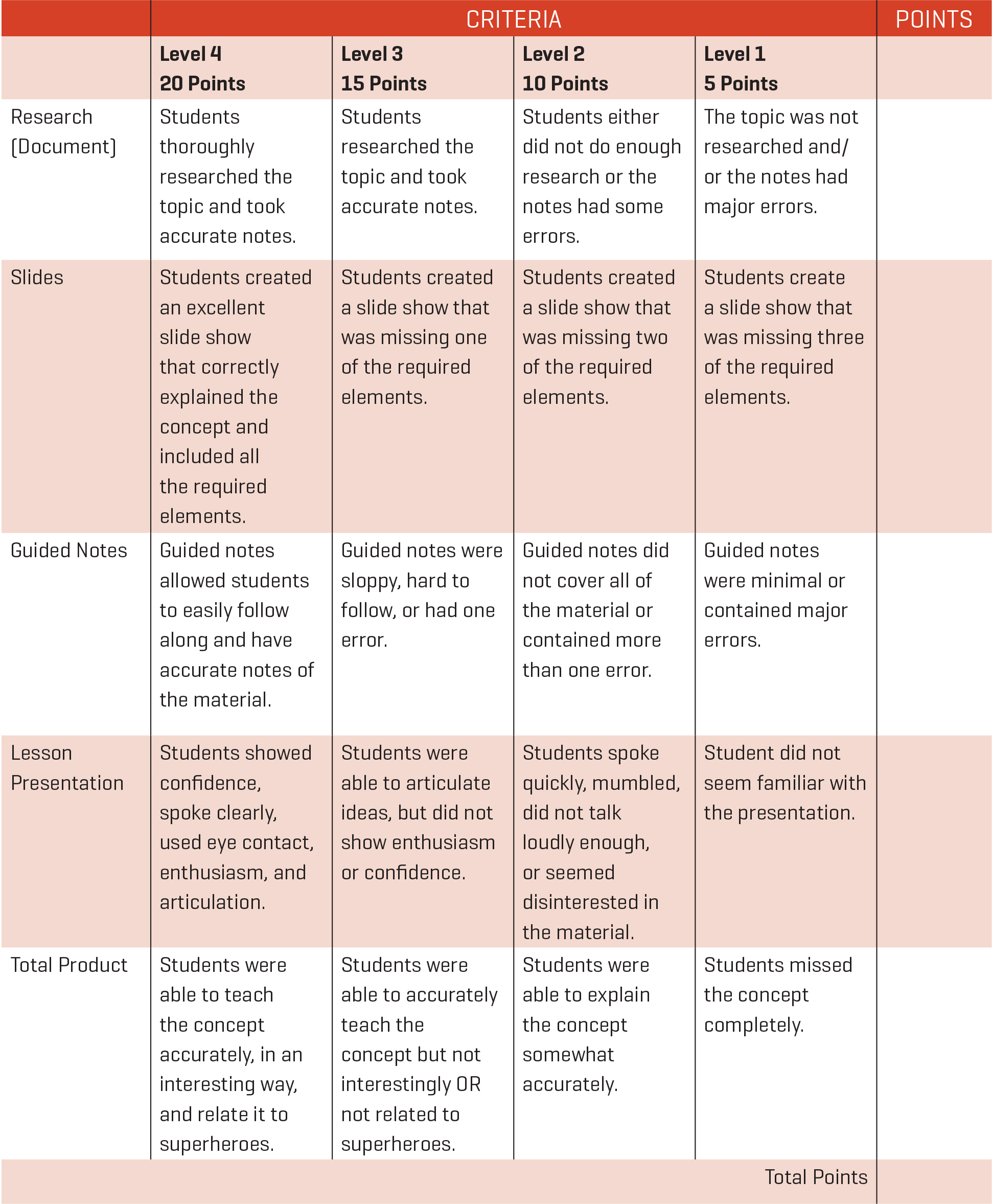
Day 1
Students were given time to meet with their teams and watch the cinema clip that was linked to their task sheet and specific to their selected EQ and super-powered individual and to discuss whether the clip demonstrated or defied the concept of their focus. The clips were provided as links on the Google Doc that was shared with them, so students could just click on the link to access the clip. (Note: To access restricted clips on YouTube, try either [1] finding the video on TeacherTube, which eliminates the comment section of YouTube; or [2] downloading the video on to your laptop and then sharing it with students that way.) Students were encouraged, but not required, to watch the full movies during their spring break and to post responses to the films on FlipGrid, a video-based social media platform that allows teachers to design and post questions to which students respond in 90-second videos. In this case, the questions were: “Which superhero/villain did you investigate?” “Which physics concept did you investigate?” and “Overall, did your character’s actions demonstrate or defy the physics you studied?” Students had until the end of the project period (about three-and-a-half weeks) to submit posts to FlipGrid. By the end of the first day, students were also expected to have chosen a presentation date. Once the clip-watching, discussion, and signup were completed, students began the research phase of the investigation.
Day 2
Students gathered information on their assigned topics using in-class resources and took notes on their shared Google Docs, defining any vocabulary given, answering the EQ(s), and explaining each science concept in detail. Because students were adding information to a shared document, all notes were collected onto one page in real time. Most groups divided the work so that each person was responsible for certain aspects and then once notes had been compiled, they looked back at the document and determined whether their notes were adequate, accurate, and useful, making revisions as needed. Students also cited their sources using APA style and shared the document with me by the end of the second day. This allowed me to review and evaluate their notes and provide feedback to them using the comment feature.
Day 3
At this point, students were able to make a connection between the physics concept and corresponding DC or Marvel superhero (or villain, as is the case with Magneto). They worked as a group to create Google Slides. Slide shows allowed the class to follow along with their presentation by taking guided notes of information that was highlighted in the slide show. I assessed the slide shows (Figure 1) in terms of how useful their inclusion was to the overall presentation and the engagement of the audience.
Slide shows either showed how their physics concept was accurately depicted by the action of their hero or how it was misrepresented by the character’s actions. For instance, two students chose to answer the EQ: Which naturally existing materials are strongest per unit of mass? This EQ pertains to Captain America’s vibranium shield, which is made of “the strongest material on Earth” (according to Marvel lore). The shield is effective at deflecting projectiles of all types and it also absorbs energy and then transfers it back in the opposite direction with equal (or sometimes greater) force. Vibranium, sadly, does not exist. The boys wanted to know if there was any real world material that is as strong as Captain America’s shield. To answer this, they had to compare a number of materials according to their ability to deflect projectiles yet still be lightweight. They determined that titanium would be best in terms of its strength per unit of mass.
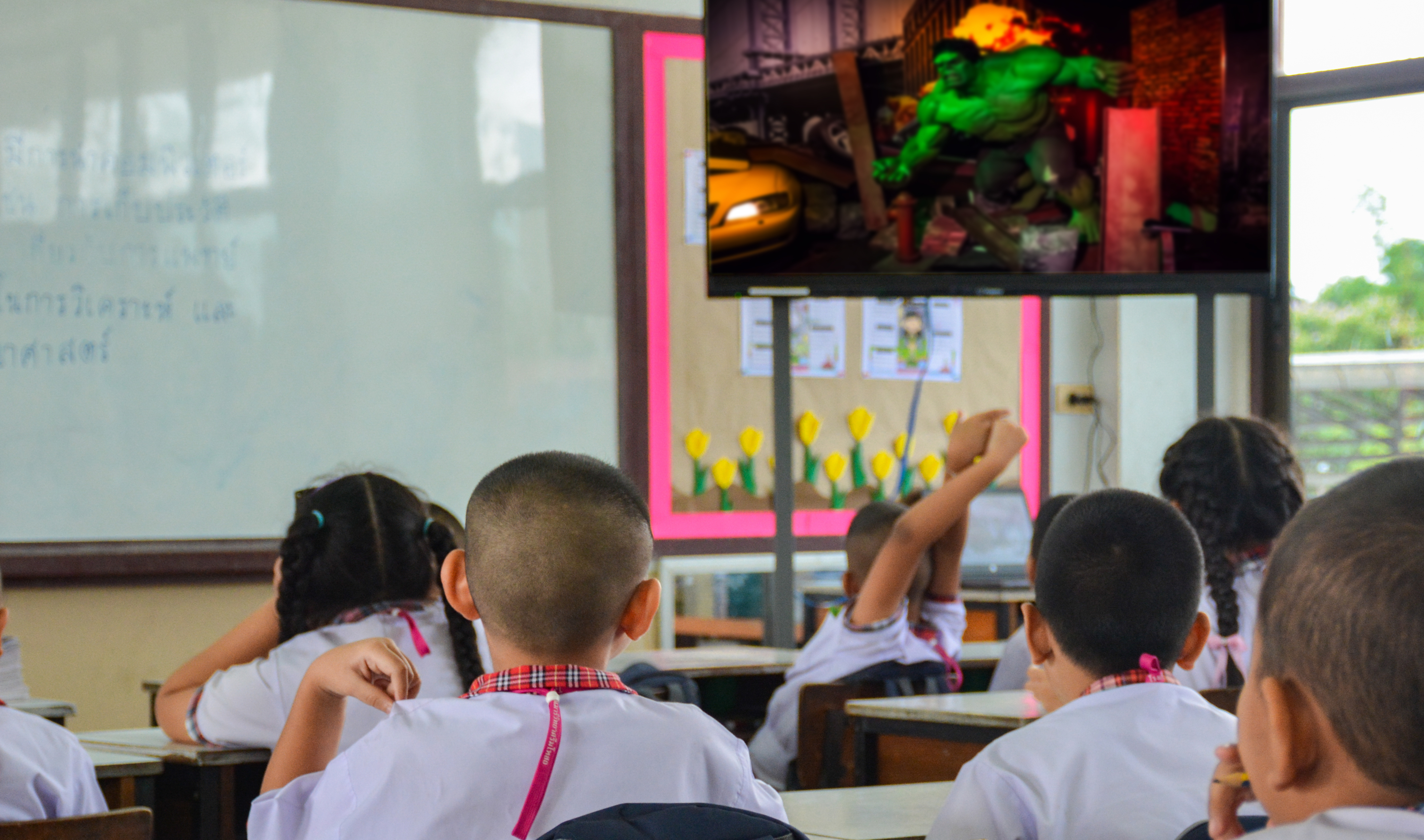
Day 4
To assist students in developing their lesson, I taught an exemplar lesson using Flash from Justice League as my point of engagement. I started with a video clip of Flash and Superman racing to determine who was faster. From there, students took guided notes while I presented information about speed, acceleration, and velocity in a slide show. We conducted an investigation on the effects of mass on speed where students used a marble, a golf ball, and a softball released from equal distances and with equal forces to attempt to knock over a standing physics textbook. After many trials, students recognized that the greater the mass of an object, the more force it exerts on the textbook (Newton’s second law). This is more of an investigation of mass and its effect on acceleration (or change in motion) than of speed, but students were able to recognize that acceleration is associated with speed in this case because the book falls from one position to another within a certain amount of time. Finally, we used a speed triangle to calculate story problems about Flash and Superman, using the speeds both are said to travel according to the comic book canon. For example, Flash’s top speed is stated as 300 million m/s. At this rate, how long would it take him to travel once around the Earth 10 times? (Earth’s circumference is 40,075 km (24,901 mi.), so traveling around the Earth 10 times would be 400,750 km or 40,075,000 m. In this case, 40,075,000 m ÷ 300,000,000 m/s = 0.13 seconds.) The lesson ended with a quick formative quiz to see if students could answer my EQ (How are speed, velocity, and acceleration related?) using a Turn-and-Talk, an oral language support strategy wherein students turn to the person sitting next to them and are given the opportunity to share their thinking with another student before they are asked to share with the whole group.
After the lesson, students were given a copy of the Performance Task Goal, Role, Audience, Situation, Product/Performance, and Standards (GRASPS) model (Figure 2; Wiggins and McTighe 2008). This gave students a better idea of how to formulate an interactive lesson by focusing on the GRASPS. The GRASPS model was selected because it is a lesson planning method that focuses on performance or product-based assessment in answer to an open-ended essential question that has relevance to the student. We debriefed my Flash lesson together as a class and identified its goal (explain the relationship between speed, acceleration, and velocity), my role (facilitator of learning), the audience (them), the situation (what we know to be true about physics is not necessarily what is shown in movies and comics), product/performance (the lesson itself), and the standards (MS-PS2-2).
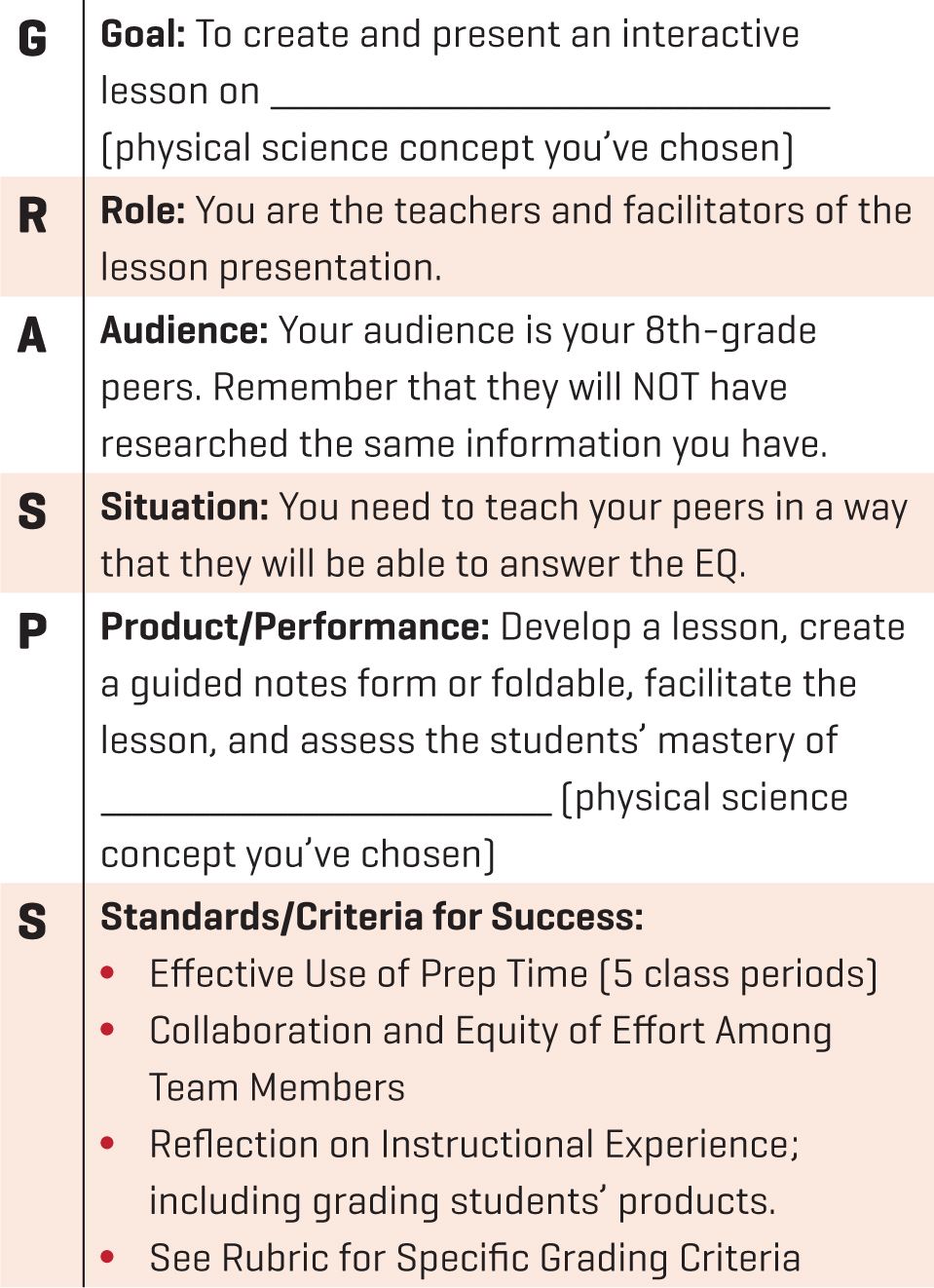
Day 5
Armed with the GRASPS model, the rubric, and some advice from me, student groups spent time developing creative, interactive, and meaningful ways to share their expertise with the rest of the class. I spent this time circulating the room, holding meetings with the groups as they worked, and addressing any alternate conceptions of concepts described in the notes they submitted after Day 2. I also answered clarifying questions about what constituted an open-ended question, whether demonstrations were allowed, and what information should be required in the notebooks. The most- often-addressed topic of clarification was about the level of audience interaction. I explained to each group that the more engaged their audience was, the better; and physical engagement (where they are actually called upon to do something) is the best type of engagement. While sitting and taking notes is doing something, students begrudgingly agreed that listening and copying notes is not all that engaging; they all admitted to times when they were doing this, but they were not engaged nor interested in what was being presented.
Day 6
On the final prep day, some students were still finishing the lesson, but most were practicing presenting the lesson among group members so that it could be taught without reading from notes. Almost every student had given presentations before in front of their peers, but none of them had ever given a presentation that involved audience participation or one that lasted an entire class period. Some of the questions team members were posing to each other (and me) were: Who would say what? In what order should we go—slide show and notes first, then activity, then exit ticket or activity first, and then explanation? What do we do if the audience isn’t listening? Do we have the authority to give infractions? In terms of questions related to the lesson, I gave students as much autonomy and interdependence as was allowed within the criteria and constraints of the challenge. I often suggested that students look back at the rubric during this time to remind them of what was expected. In terms of general classroom management questions, I told them that natural consequences (such as not passing the post-lesson formative assessment) will likely be experienced by those who are not taking notes. However, because you are the leader of the lesson when you are presenting, you can determine whether it’s a good time for your “students” to use the restroom, or redirect their attention if you notice it is waning.
Students’ lesson presentations far exceeded my expectations. All told, we spent almost two weeks learning about momentum (as it pertained to Wonder Woman), energy transfer and transformation (while discussing Black Panther’s vibranium suit), reference points and distance (as demonstrated by Spider-Man’s web slinging), static and current electricity (wielded by Storm), the engineering design process (demonstrated by Batman), and even materials science (showing weapons and their effectiveness against Captain America’s vibranium shield). Students were knowledgeable and generally able to effectively engage and inform their audiences (see Figure 3 for summaries of group lessons).
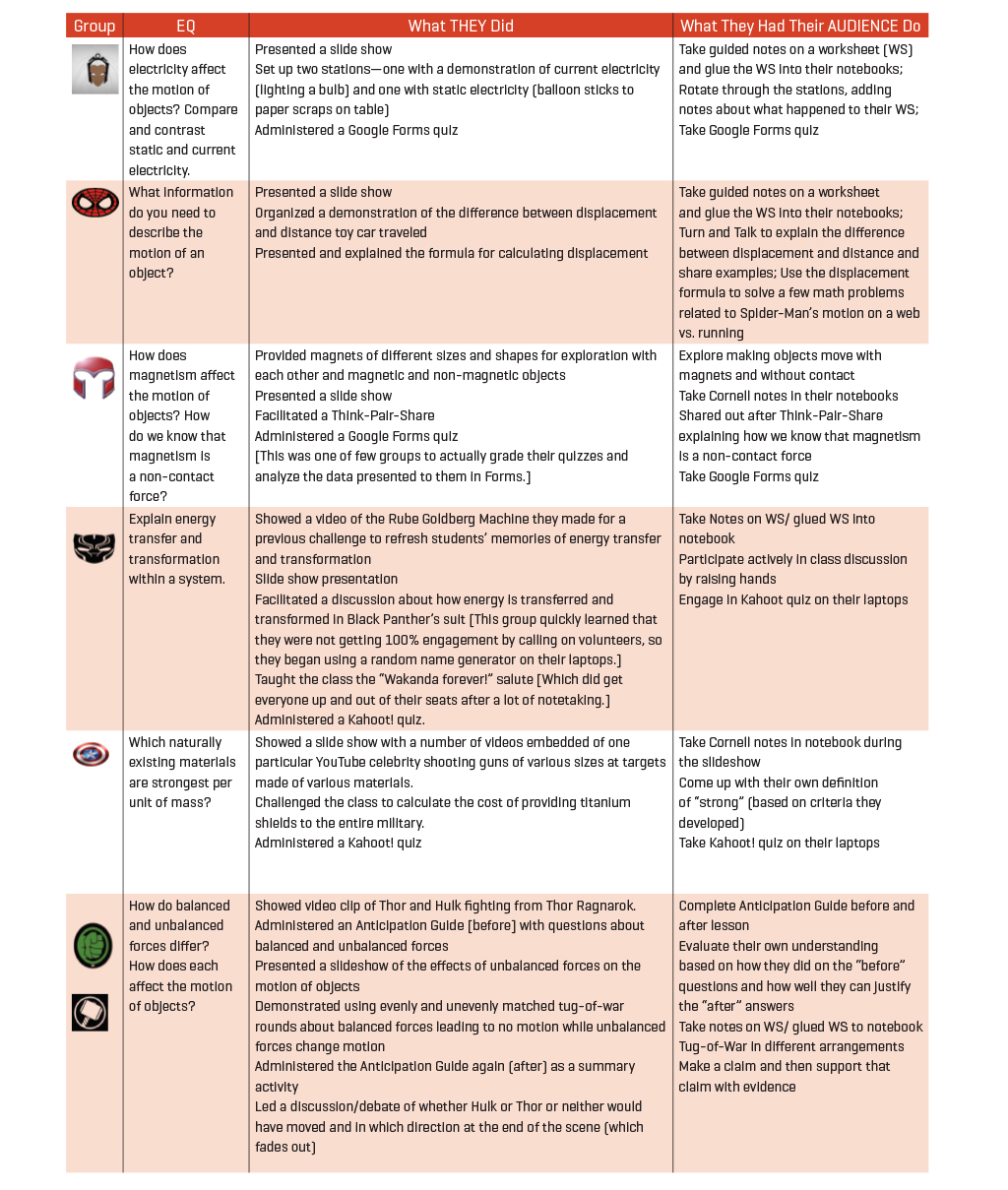
As students taught, I took notes on their rubrics. Not only did this make scoring the presentations easy, it also allowed me to record information from the lessons that I thought was important. My notes were used to develop a formative assessment for each class that was based on that class’s presentation. Because students were allowed to use their notes, anyone who was paying attention and actively involved during the lessons was able to answer the assessment questions easily. It informed me of (1) how well students were engaged in the lessons, (2) how clear the information presented was, and (3) students’ understanding of physics concepts to that point. Any gaps revealed in the item analysis of the assessments could be addressed by me in the class time prior to the end-of-semester summative assessment.
Physics Teaching Strategies Middle School



